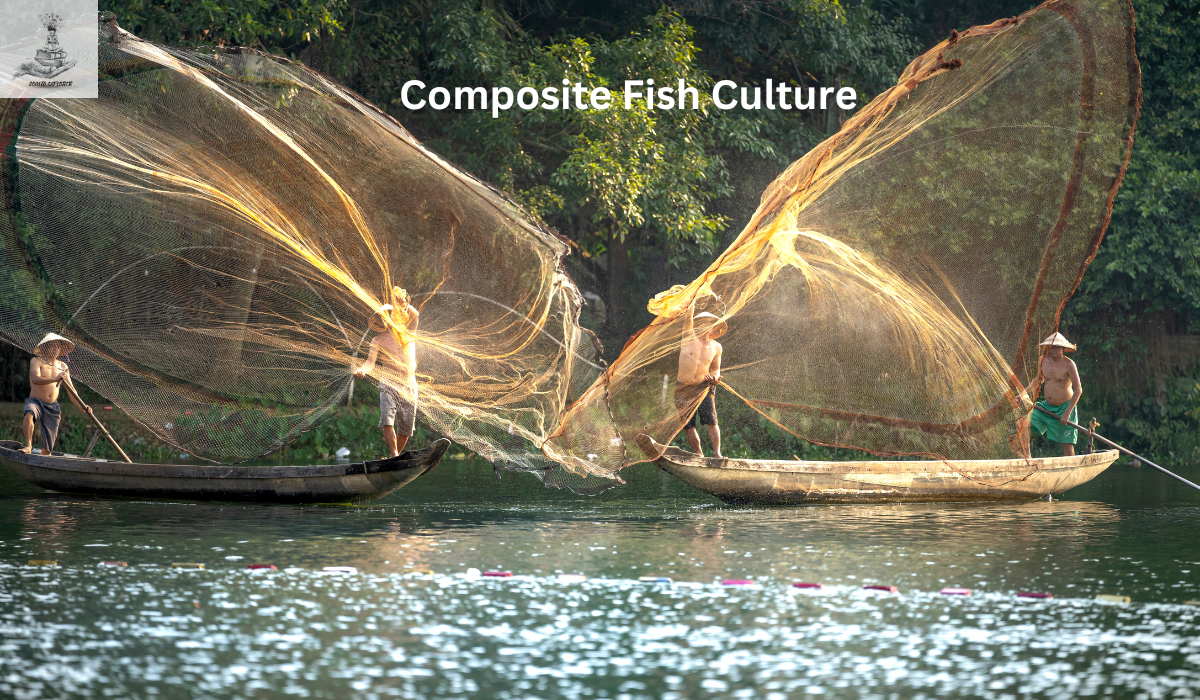Composite Fish Culture
Introduction
Hey, ever heard of aquaculture? It’s like growing fish and other water creatures. Well, now there’s this cool thing called composite fish culture. It’s like a mix of fish farming with other farming stuff. And you know what’s cool? It’s becoming really popular because it has a bunch of advantages.
In simple words, composite fish culture is like creating a fish dream team that works together to grow big and strong. It’s not just good for the fish but also for the people who take care of them.
Definition of Composite Fish Culture
Composite fish culture involves the concurrent cultivation of multiple fish species in the same pond. This method aims to maximize productivity and optimize resource utilization by creating a balanced ecosystem within the water body.

Origin of Fish Culture
The practice of fish culture dates back thousands of years, with evidence suggesting that the ancient Chinese were among the first to cultivate fish for food. Over time, various civilizations, including the Romans and Egyptians, adopted different forms of fish farming. However, the concept of Composite Fish Culture as we know it today emerged in the mid-20th century as a response to the challenges posed by monoculture systems.
Ancient China
Around 2000 BC, ancient Chinese communities pioneered fish farming by cultivating carp in artificial ponds. This innovative approach to raising fish proved successful and spread across Asia, laying the foundation for aquaculture.
Ancient Rome
Venturing into the Western world, the ancient Romans contributed to fish culture by constructing fish ponds. These water bodies served dual purposes, providing a sustainable source of food and adding an ornamental touch to their surroundings.
Medieval Europe
During medieval times, European monasteries took center stage in the cultivation of fish. Monks utilized fish ponds, honing techniques to enhance production. Carp became a staple during religious fasting periods, solidifying the role of fish culture in European culinary traditions.
18th and 19th Centuries
The 18th and 19th centuries witnessed a leap forward in fish farming. European experimentation expanded to include species like trout and salmon, marking a crucial step toward modern aquaculture practices.
20th Century and Beyond
Fast forward to the 20th century, and fish culture underwent significant transformations. Technological advancements, coupled with a deeper understanding of fish biology, propelled aquaculture into a global industry. Trout, salmon, and an array of species became integral to the world’s seafood production.
What are the advantages of composite fish culture?

Increased Productivity
One of the primary benefits of composite fish culture is the significant increase in overall productivity. By cultivating multiple fish species simultaneously, farmers can capitalize on diverse ecological niches, resulting in a higher yield per unit of water.
Efficient Resource Utilization
Unlike traditional fish farming, where a single species dominates, It optimizes resource utilization. Different species occupy distinct ecological niches, reducing competition for resources and minimizing waste.
Biodiversity Enhancement
It promotes biodiversity within aquatic ecosystems. The coexistence of various fish species fosters a natural balance, reducing the risk of outbreaks of specific diseases and enhancing the overall resilience of the system.
Risk Mitigation
Diversification in fish species acts as a risk mitigation strategy. If one species faces challenges such as disease or market fluctuations, others may thrive, ensuring a more stable income for farmers.
Components of Composite Fish Culture
Selection of Fish Species
Choosing compatible fish species is crucial for the success of culture. Compatibility in terms of feeding habits, water quality preferences, and growth rates must be considered.
Integration with Agriculture
Linking fish farming with agriculture creates a symbiotic relationship. Fish waste serves as a natural fertilizer for crops, and the vegetation around the pond provides shade and helps maintain water quality.
Water Management
Proper water management is essential for success. Regular monitoring of water quality, aeration, and maintaining suitable water depth are key components.
Feeding Techniques
Implementing efficient feeding techniques ensures that all fish species receive adequate nutrition. This involves understanding the dietary requirements of each species and adjusting feeding practices accordingly.
Economic Benefits
Income Generation
It contributes significantly to income generation for farmers. The diversified production allows for a steady and diversified income stream throughout the year.
Employment Opportunities
As it expands, it creates employment opportunities in various stages of the production cycle, from pond preparation to harvesting and marketing.
Environmental Impact
Sustainable Practices
The integrated approach of this will align with sustainable farming practices. By utilizing natural processes and minimizing external inputs, this method reduces the environmental impact associated with conventional aquaculture.
Reduced Environmental Footprint
The reduced need for antibiotics and chemicals in this may result in a smaller environmental footprint. This approach aligns with the global push towards more sustainable and eco-friendly farming practices.
Challenges and Solutions
Disease Management
Despite its advantages, this faces challenges, including the risk of diseases affecting multiple species. Implementing strict biosecurity measures and regular health checks are essential to address this issue.
Market Accessibility
Connecting farmers with markets can be challenging. Developing efficient marketing channels and providing support in accessing markets will enhance the economic viability of composite fish culture.
Training and Education
To overcome challenges, adequate training and education programs are necessary. Educating farmers about best practices, disease management, and market trends ensures the sustained success of the culture.
Future Prospects
Innovations in Composite Fish Culture
Ongoing research and development continue to bring innovations to this, enhancing its efficiency and sustainability.
Global Adoption
The potential of culture to address food security and environmental concerns positions it for widespread global adoption. Governments, NGOs, and farmers worldwide are increasingly recognizing its benefits.
Conclusion
Composite fish culture emerges as a holistic approach to aquaculture, offering a multitude of advantages ranging from increased productivity to environmental sustainability. As the world seeks innovative solutions to address food security and environmental challenges, composite fish culture stands out as a promising practice.
FAQs
Is composite fish culture suitable for small-scale farmers?
Yes, the flexibility and scalability of the culture make it suitable for small-scale farmers, providing them with diversified income opportunities.
How does composite fish culture contribute to environmental sustainability?
By minimizing the use of chemicals and promoting natural processes, it can reduce the environmental impact associated with traditional aquaculture.
What challenges do farmers commonly face in adopting composite fish culture?
Farmers may encounter challenges related to disease management, market accessibility, and the need for proper training. However, these challenges can be addressed through support systems.
Can composite fish culture be integrated with other farming practices?
Yes, this is often integrated with agriculture, creating a symbiotic relationship where fish farming benefits from crop residues, and vice versa.
Are there government initiatives supporting the adoption of composite fish culture?
Many governments recognize the potential of composite fish culture and offer initiatives, subsidies, and training programs to encourage its adoption among farmers.







